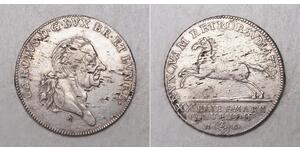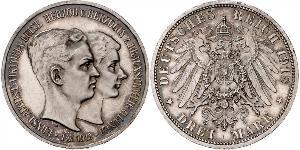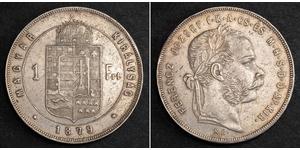1 Thaler (售价 $46.0)
1779, Brunswick-Wolfenbuttel, Charles I. Silver 2/3 Thaler Coin. 1-Yr Bust Type!
Mint Year: 1779
Mint Place: Brunswick
Reference: KM-983.2.
Denomination: 2/3 Thaler
Mint Official: Christian Friedrich Krull (K, die-cutter)
Condition: Mint-made planchet imperfection (silver alloy impurities), faint weight-adjusting marks, otherwise about VF-XF!
Weight: 13.88gm
Diameter: 32mm
Material: Silver
Obverse: Small bust of Charles I right. Die cutter´s initial (K) below bust truncation.
Legend: CAROLVS D . G . DVX BR . ET LVNEB .
Reverse: Leaping horse left, in exergue value inside oval frame below, flanked by mint official´s initials (M.-C.).
Legend: NVNQVAM RETRORSVM ("Never Backwards!") . 1779 .
Exergue: XX . EINE FEINE MARCK CONVENT . M . / M (2/3) . C .
The Duchy of Brunswick-Lüneburg (German: Herzogtum Braunschweig-Lüneburg), or more properly the Duchy of Brunswick and Lüneburg, was an historical duchy that existed from the late Middle Ages to the Early Modern era within the Holy Roman Empire. The duchy was located in what is now northwestern Germany. Its name came from the two largest cities in the territory: Brunswick and Lüneburg. The dukedom emerged in 1235 from the allodial lands of the House of Welf in Saxony and was granted as an imperial fief to Otto the Child, a grandson of Henry the Lion. The duchy was divided several times during the High Middle Ages amongst various lines of the House of Welf, but each ruler was styled "Duke of Brunswick-Lüneburg" in addition to his own particular title. By 1692, the territories had consolidated to two: the Electorate of Brunswick-Lüneburg (Hanover) and the Principality of Brunswick-Wolfenbüttel. In 1714, the Hanoverian branch of the family succeeded to the throne of Great Britain, which they would rule in personal union with Hanover until 1837. For this reason, many cities and provinces in former British colonies are named after Brunswick or Lüneburg. The Hanoverians never ruled Brunswick while they held the British throne, as the city was part of neighboring Brunswick-Wolfenbüttel. After the Congress of Vienna in 1814/15, the Brunswick-Lüneburg territories became the Kingdom of Hanover and the Duchy of Brunswick.
Charles William Ferdinand, Duke of Brunswick-Lüneburg, Prince of Brunswick-Wolfenbuttel-Bevern (Karl Wilhelm Ferdinand, Herzog zu Braunschweig-Lüneburg, Fürst von Braunschweig-Wolfenbüttel-Bevern) (October 9, 1735 - October 16, 1806) was a sovereign prince of the Holy Roman Empire, and a professional soldier who served as a Generalfeldmarschall of the Kingdom of Prussia. Born in Wolfenbüttel, Germany, he was duke of Brunswick-Lüneburg from 1780 until his death and ruled over the Wolfenbüttel subdivision of the duchy. He is a recognized master of the modern warfare of the mid-18th century, a cultured and benevolent despot in the model of Frederick the Great, and was married to Augusta, a sister of George III of Great Britain.
Charles William Ferdinand (German: Karl Wilhelm Ferdinand) was the son of Charles I, Duke of Brunswick-Lüneburg and Philippine Charlotte, daughter of King Frederick William I of Prussia. Karl received an unusually wide and thorough education, and travelled in his youth in the Netherlands, France and various parts of Germany. His first military experience was in the North German campaign of 1757, under Prince William Augustus, Duke of Cumberland. At the Battle of Hastenbeck he won great renown by a gallant charge at the head of an infantry brigade; and upon the capitulation of Kloster Zeven he was easily persuaded by his uncle Ferdinand of Brunswick, who succeeded Cumberland, to continue in the war as a general officer. The exploits of the hereditary prince, as he was called, soon gained him further reputation, and he became an acknowledged master of irregular warfare. In pitched battles, and in particular at Minden and Warburg, he proved himself an excellent subordinate.
After the close of the Seven Years' War, the prince visited England with his bride, the daughter of Frederick, Prince of Wales, and in 1766 he went to France, being received both by his allies and his late enemies with every token of respect. In Paris he made the acquaintance of Marmontel; in Switzerland, whither he continued his tour, that of Voltaire; and in Rome, where he remained for a long time, he explored the antiquities of the city under the guidance of Winckelmann. After a visit to Naples he returned to Paris, and thence, with his wife, to Brunswick. His services to the dukedom during the next few years were of the greatest value; with the assistance of the minister Feonçe von Rotenkreuz he rescued the state from the bankruptcy into which the war had brought it. His popularity was unbounded, and when he succeeded his father, Duke Karl I, in 1780, he soon became known as a model to sovereigns.
1 Lira 意大利王國 (1861-1946) 銀 维托里奥·埃马努埃莱二世
本组有 9 钱币 / 8 售价
⇑
1 Forint 奥匈帝国 (1867 - 1918) 銀 弗朗茨·约瑟夫一世 (1830 - 1916)
本组有 18 钱币 / 17 售价
⇑





 English
English





-300-150-cNoKbzbiUSoAAAFNd79tvw0D.jpg)

-300-150-Vw4KbzbiGiUAAAFRtHOWyoBd.jpg)






